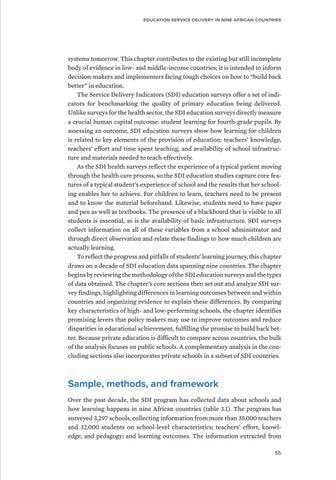Education service delivery in nine African countries
systems tomorrow. This chapter contributes to the existing but still incomplete body of evidence in low- and middle-income countries; it is intended to inform decision-makers and implementers facing tough choices on how to “build back better” in education. The Service Delivery Indicators (SDI) education surveys offer a set of indicators for benchmarking the quality of primary education being delivered. Unlike surveys for the health sector, the SDI education surveys directly measure a crucial human capital outcome: student learning for fourth-grade pupils. By assessing an outcome, SDI education surveys show how learning for children is related to key elements of the provision of education: teachers’ knowledge, teachers’ effort and time spent teaching, and availability of school infrastructure and materials needed to teach effectively. As the SDI health surveys reflect the experience of a typical patient moving through the health care process, so the SDI education studies capture core features of a typical student’s experience of school and the results that her schooling enables her to achieve. For children to learn, teachers need to be present and to know the material beforehand. Likewise, students need to have paper and pen as well as textbooks. The presence of a blackboard that is visible to all students is essential, as is the availability of basic infrastructure. SDI surveys collect information on all of these variables from a school administrator and through direct observation and relate these findings to how much children are actually learning. To reflect the progress and pitfalls of students’ learning journey, this chapter draws on a decade of SDI education data spanning nine countries. The chapter begins by reviewing the methodology of the SDI education surveys and the types of data obtained. The chapter’s core sections then set out and analyze SDI survey findings, highlighting differences in learning outcomes between and within countries and organizing evidence to explain these differences. By comparing key characteristics of high- and low-performing schools, the chapter identifies promising levers that policy makers may use to improve outcomes and reduce disparities in educational achievement, fulfilling the promise to build back better. Because private education is difficult to compare across countries, the bulk of the analysis focuses on public schools. A complementary analysis in the concluding sections also incorporates private schools in a subset of SDI countries.
Sample, methods, and framework Over the past decade, the SDI program has collected data about schools and how learning happens in nine African countries (table 3.1). The program has surveyed 3,297 schools, collecting information from more than 35,000 teachers and 32,000 students on school-level characteristics; teachers’ effort, knowledge, and pedagogy; and learning outcomes. The information extracted from 55


